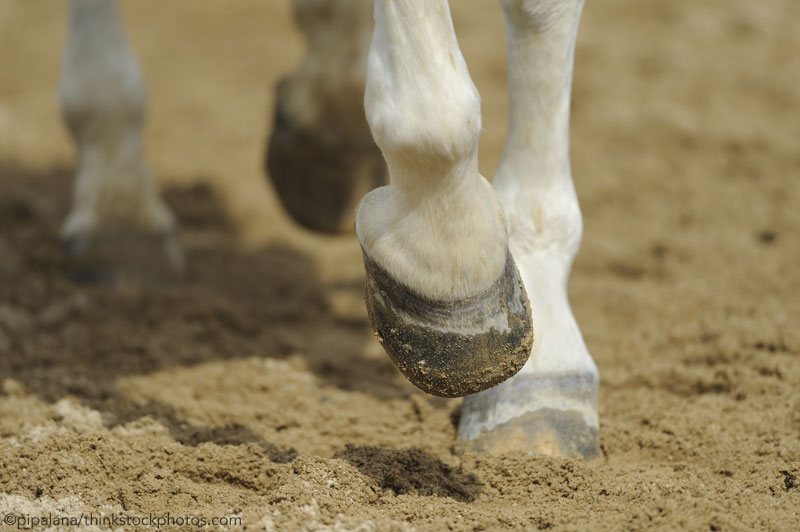Whether your horse is blessed with fantastic feet or you are all too familiar with the hoof blues, regular attention to hoof care pays off in spades. A sound and healthy horse starts from the bottom up.
Everyday Hoof Care

Be aware of your horse’s living environment: avoid as much as possible exposing your horse to rocky, wet, or muddy conditions. Excessive moisture may increase bacterial growth, which can lead to thrush and white line disease; rocky surfaces can bring about bruises and abscesses; and wet/dry cycles cause the hoof to expand and contract, potentially leading to cracks and loosening clinches.
Find the Right Farrier
The place to start with ensuring your horse’s feet are at their best is to develop a relationship with a skilled farrier. While there are no mandatory licensing requirements in the U.S. to practice farriery, voluntary certification programs underscore a shoer’s knowledge, experience and skill. The American Farriers Association and the American Association of Professional Farriers, for example, offer certification programs farriers can take part in to verify their competency.
“Horse owners need to be more proactive about picking farriers that are better trained,” explains Mitch Taylor, CJF and AWCF, of the Kentucky Horseshoeing School. “In this country, we don’t have any minimum standards that one has to attain to be a farrier, so therefore anyone can shoe horses. The balancing and maintenance of the hoof is a critical part of the horse’s health, welfare, and comfort. It is a specialized trade. We can’t expect owners to know all the ins and outs.”
Look for a shoer with credentials, a quality education, and satisfied clients who are willing to serve as references. Word of mouth also goes a long way: ask for recommendations among your equine network.
Scheduling Farrier Appointments
Work together with your farrier (and vet) to establish a schedule that suits your horse’s needs, generally somewhere in the realm of six-week intervals. Don’t try to stretch out your farrier’s appointments: going too long can lead to overly long toes, distortion, flares, dishes, and flat soles. Farrier care is not a place to pinch pennies.
Hoof Health From the Inside Out
Healthy hoof growth requires good nutrition. Dr. Clair Thunes, PhD, of Summit Equine Nutrition names four key components: the minerals zinc and copper (in a 3:1- 5:1 zinc to copper ratio), the amino acid methionine, and fatty acids. In addition, biotin has also been implicated in enhancing hoof integrity. These nutrients work together to bolster hoof resiliency and aid hoof growth.
“My approach has always been to get the base diet where it needs to be by selecting the correct feed and hay; you can then add a hoof supplement if needed,” explains Thunes. “With balanced minerals and quality protein, you have all the building blocks to have the best feet your horse can have.”
Consult with your veterinarian, equine nutritionist, or feed representative for guidelines on an appropriate diet for your horse. Be aware that even with the best possible nutrition, some horses are naturally predisposed to better hooves than others.
Topical Hoof Treatments
Topical applications also have a place in your hoof-care toolkit, depending on your horse’s environment and individual needs. Dry, brittle hooves may benefit from a moisturizing hoof ointment, while overly soft feet could use a topical hardener. A thrush treatment is a good stand-by for the tell-tale thrushy smell you may encounter when picking out hooves.
Shod or Barefoot?
Shod or barefoot depends on each individual scenario; with the right situation, going barefoot can be a viable option. A horse with good hooves working in a discipline in which shoes are not a must may forgo shoes. Forgiving surfaces- think nonabrasive and devoid of rocks- are crucial to avoiding wear-and-tear and bruising. Hoof boots may be appropriate in circumstances in which a barefoot horse needs extra protection.
Just because your horse is barefoot, however, doesn’t mean you can skip farrier visits; regular trimming maintains correct hoof conformation, ensuring structures are correctly loaded.
Good Old-Fashioned Horsemanship
You know you’ve found your hoof-care sweet spot when your horse is sound, even, and balanced. With a little diligence, your horse will not only stay comfortable, he’ll be able to perform at his best. Daily attention, a balanced diet, and regular visits from a good farrier are a simple formula for your horse’s best hoof-care scenario.
Natalie DeFee Mendik is an award-winning journalist specializing in equine media. Visit her online at www.MendikMedia.com.





